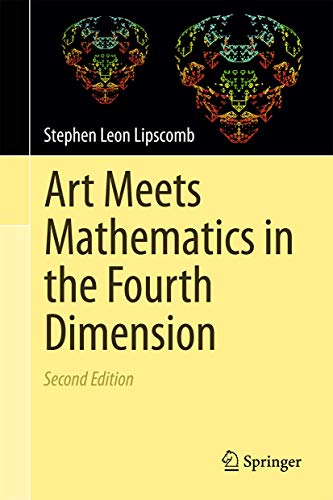Artículos relacionados a Art Meets Mathematics in the Fourth Dimension

To see objects that live in the fourth dimension we humans would need to add a fourth dimension to our three-dimensional vision. An example of such an object that lives in the fourth dimension is a hyper-sphere or “3-sphere”. The quest to imagine the elusive 3-sphere has deep historical roots: medieval poet Dante Alighieri, in his circa 1300 AD Divine Comedy, used a 3-sphere to convey his allegorical vision of the Christian afterlife. In 1917, Albert Einstein visualized the universe, at each instant in time, as a 3-sphere. He described his representation as “...the place where the reader’s imagination boggles. Nobody can imagine this thing.” Over time, however, our understanding of the concept of dimension evolved. By 2003, a researcher had successfully rendered into human vision the structure of a 4-web (think of an every increasingly-dense spider’s web). In this text Stephen Lipscomb takes his innovative dimension theory research a step further, using the 4-web to reveal a new partial image of a 3-sphere. Illustrations support the reader’s understanding of the mathematics behind this process. Lipscomb describes a computer program that can produce partial images of a 3-sphere and suggests methods of discerning other fourth-dimensional objects that may serve as the basis for future artwork.
Reviews
The author’s notion of fractal-based computer art is fascinating-a clear expression of our technological age. With the color plates in this book and the available DVD animation the reader will not only substantiate this, but will also gain an intuitive sense about the nature of fractals and about the structure and origin of the 4-web. A.D. Parks, Ph.D., Principal Scientist, Head of Quantum Physics Group, Naval Surface Warfare Center, Dahlgren Virginia
Using numerous illustrations, the author discusses the idea of a fourth dimension. The new feature here is his use of an object that up until recently lived only in the fourth dimension. This book should become useful, educational, and widely-read. Gerald Edgar, Professor (Emeritus) of Mathematics, The Ohio State University
I have read many books, but only a couple has been as suggestive in terms of connections between mathematics, art, and physics as this book. It will be exceptionally well received. John E. Gray, Senior Member of IEEE, Lead physicist (over 130 publications)
An accessible yet rigorous treatment of recent mathematical research, this book is particularly valuable since its author developed these concepts originally. J. Larry Lehman, Professor of Mathematics, University of Mary Washington
"Sobre este título" puede pertenecer a otra edición de este libro.
- EditorialSpringer
- Año de publicación2014
- ISBN 10 3319062530
- ISBN 13 9783319062532
- EncuadernaciónTapa dura
- Número de edición2
- Número de páginas204
Comprar nuevo
Ver este artículo
Gastos de envío:
EUR 23,00
De Alemania a Estados Unidos de America
Los mejores resultados en AbeBooks
Art Meets Mathematics in the Fourth Dimension
Descripción Buch. Condición: Neu. This item is printed on demand - it takes 3-4 days longer - Neuware -To see objects that live in the fourth dimension we humans would need to add a fourth dimension to our three-dimensional vision. An example of such an object that lives in the fourth dimension is a hyper-sphere or '3-sphere.' The quest to imagine the elusive 3-sphere has deep historical roots: medieval poet Dante Alighieri used a 3-sphere to convey his allegorical vision of the Christian afterlife in his Divine Comedy. In 1917, Albert Einstein visualized the universe as a 3-sphere, describing this imagery as 'the place where the reader's imagination boggles. Nobody can imagine this thing.' Over time, however, understanding of the concept of a dimension evolved. By 2003, a researcher had successfully rendered into human vision the structure of a 4-web (think of an ever increasingly-dense spider's web). In this text, Stephen Lipscomb takes his innovative dimension theory research a step further, using the 4-web to reveal a new partial image of a 3-sphere. Illustrations support the reader's understanding of the mathematics behind this process. Lipscomb describes a computer program that can produce partial images of a 3-sphere and suggests methods of discerning other fourth-dimensional objects that may serve as the basis for future artwork. 204 pp. Englisch. Nº de ref. del artículo: 9783319062532
Art Meets Mathematics in the Fourth Dimension
Descripción Buch. Condición: Neu. Druck auf Anfrage Neuware - Printed after ordering - To see objects that live in the fourth dimension we humans would need to add a fourth dimension to our three-dimensional vision. An example of such an object that lives in the fourth dimension is a hyper-sphere or '3-sphere.' The quest to imagine the elusive 3-sphere has deep historical roots: medieval poet Dante Alighieri used a 3-sphere to convey his allegorical vision of the Christian afterlife in his Divine Comedy. In 1917, Albert Einstein visualized the universe as a 3-sphere, describing this imagery as 'the place where the reader's imagination boggles. Nobody can imagine this thing.' Over time, however, understanding of the concept of a dimension evolved. By 2003, a researcher had successfully rendered into human vision the structure of a 4-web (think of an ever increasingly-dense spider's web). In this text, Stephen Lipscomb takes his innovative dimension theory research a step further, using the 4-web to reveal a new partial image of a 3-sphere. Illustrations support the reader's understanding of the mathematics behind this process. Lipscomb describes a computer program that can produce partial images of a 3-sphere and suggests methods of discerning other fourth-dimensional objects that may serve as the basis for future artwork. Nº de ref. del artículo: 9783319062532
Art Meets Mathematics in the Fourth Dimension
Descripción Condición: New. Dieser Artikel ist ein Print on Demand Artikel und wird nach Ihrer Bestellung fuer Sie gedruckt. Develops the concept of the hypersphere dimensions as it relates to art, architecture, and mathematicsIncludes illustrations to support mathematical analysesDiscusses computer software that enables new hypersphere research and visualization. Nº de ref. del artículo: 4497518

